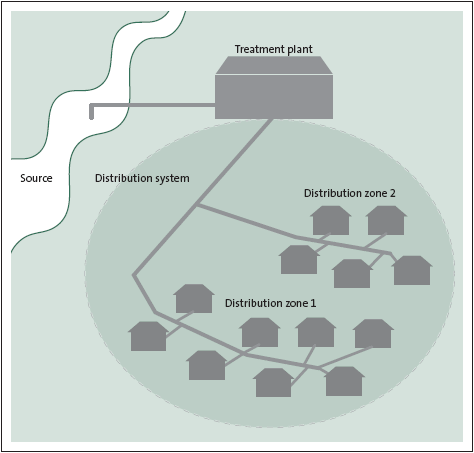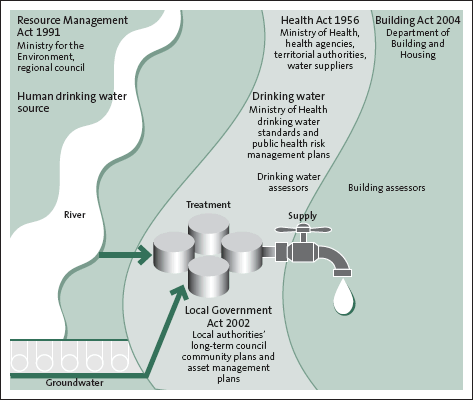Part 2: Background
2.1
In this Part, we briefly discuss:
- how drinking water is supplied;
- why demand forecasting is important;
- the types of strategies that local authorities can use to meet the forecast demand for drinking water; and
- what we consider necessary for local authorities to effectively manage drinking water supply.
How drinking water is supplied
2.2
Many local authorities directly manage how drinking water is supplied, but others have contracted out the operational and maintenance services. Some local authorities have established council-controlled organisations to manage how drinking water is supplied.
2.3
There are usually three parts to the system for supplying drinking water: a source, a treatment plant, and a distribution system. Figure 1 shows these three parts.
2.4
The three main sources for drinking water are:
- surface water (streams, rivers, and lakes);
- groundwater (water drawn from bores or wells); and
- roof catchment (rainwater collected on roofs and stored for later use).
2.5
Treatment plants can be large or small operations. They can be a series of automated treatment processes, or plants that use a manually controlled single treatment process, or a single pump drawing water from a source (usually groundwater) with or without any treatment.
2.6
Distribution systems carry drinking water from the treatment plant to the consumers. The distribution system is made up of the pipes, water storage facilities (tanks or reservoirs), and any other components situated between the treatment plant and the boundary of the consumer's property. The pipes used to distribute drinking water are also referred to as "reticulation".
Figure 1
The three parts of a typical supply system to provide a community with drinking water

Source: Chris Nokes, Institute of Environmental Science and Research Limited (2008), A Guide to the Ministry of Health Drinking-water Standards for New Zealand, Ministry for the Environment, Wellington.
Legislative framework
2.7
Four main Acts set the legislative framework for drinking water supply. They are the:
- Health Act 1956;
- Local Government Act 2002;
- Building Act 2004; and
- Resource Management Act 1991.
2.8
Figure 2 shows the boundaries and links between these Acts, as they apply to a typical system for supplying people with drinking water.
Figure 2
How legislation applies to the parts of a typical system for supplying people with drinking water

Source: Adapted from Ministry for the Environment (2009), Draft Users' Guide: National Environmental Standard for Sources of Human Drinking Water, Wellington.
2.9
The Health Act covers the quality of the drinking water that is provided to consumers.
2.10
The Health (Drinking Water) Amendment Act was passed in October 2007 and took effect from 1 July 2008. Before this, local authorities had more discretion in the quality of the water they supplied to their communities. This Act does not require compliance with the drinking water standards but it does require the suppliers of drinking water to take "all practicable steps" to comply. The Ministry of Health considers that taking steps to implement an approved public health risk management plan is enough to comply with "all practicable steps". A public health risk management plan is a quality assurance programme for providing drinking water.
2.11
In relation to supplying water, the Local Government Act requires each local authority to carry out demand forecasting, evaluate options to meet current and forecast demand, and identify how the authority will meet this demand. Section 130 of the Act also requires local authorities to continue to provide water services and prevents them from selling the assets used to supply such services.
2.12
More generally, the Local Government Act requires local authorities to assess and plan for the future needs of their communities, taking a sustainable development approach and using a decision-making framework that covers consultation, planning, and accountability. LTCCPs outline how local authorities intend to contribute to community outcomes and provide an opportunity for the community to participate in local decision-making.
2.13
The Building Act applies to water delivery systems inside buildings that are connected to a water supply system provided by a local authority or community, and also applies to the water supplies of buildings that have an individual water supply (such as a rainwater tank). In our audit, we did not examine the Building Act aspects of supplying drinking water.
2.14
The main piece of legislation for managing freshwater is the Resource Management Act. Again, this was not a focus of our audit.
Why forecasting the likely demand is important
2.15
Demand forecasting involves predicting how much drinking water will be needed in the future and where it will be needed. Local authorities need to identify the main factors and trends that influence the demand for drinking water and prepare projections for that demand over time. Forecasts provide a basis for designing and budgeting for drinking water supplies. They also provide a basis for preparing a strategy to secure sources of water. Forecasting water demand is a critical part of the asset management and planning process.
2.16
It is important that local authorities take all practicable steps to use a reliable forecasting technique because it can be difficult to accurately forecast future trends. A reliable forecast can help ensure that the local authority supplies enough drinking water for domestic and industrial use, while allowing for future growth and development. It can also contribute to a more efficient use of ratepayers' funds, because the infrastructure is the right size to meet the need. See Appendix 2 for more information on how councils forecast demand.
Strategies for meeting the forecast demand
2.17
Local authorities can use a wide range of strategies to meet the forecast demand for drinking water. The choice of strategies will depend on the circumstances of each local authority.
2.18
These strategies generally fall into two broad groups – supply strategies and demand strategies.
2.19
Supply strategies deal with how drinking water is produced and delivered to consumers. Generally, they are asset management solutions to meet growing and changing demand. Supply strategies can include, for example, ongoing maintenance and renewals, controlling leaks or other system efficiency2 changes, and proposals for new or replacement infrastructure.
2.20
Demand strategies deal with how consumers use drinking water. Demand strategies generally attempt to change the pattern of demand to minimise or eliminate the need to upgrade the infrastructure that supplies the water. Demand strategies can include: metering and charging for drinking water, water restrictions, and public education programmes about conserving water. Taking these actions can reduce the need to upgrade the infrastructure and reduce the demand placed on water sources.
Meeting the forecast demand by effectively managing how drinking water is supplied
2.21
In our view, for local authorities to effectively manage their drinking water supply means:
- having and using good quality data (for example, about water supplies and water consumption, existing population patterns and expected changes, and existing land use patterns and expected changes);
- using a reliable technique to forecast what the future demand might be, and verifying that forecast;
- thoroughly assessing a wide range of supply and demand management strategies; and
- using the above information to build or upgrade infrastructure at the right time and to the right scale.
2: A water supply system increases in efficiency when there are fewer system losses without any change in how consumers are using water. Systems can be made more efficient by detecting and repairing leaks, reducing water pressure, changing how the mains are flushed and reservoirs are cleaned, and installing mechanisms for balancing peak demands.
page top